Argentinos Juniors: The 'Argentinean Ajax' where Diego Maradona emerged
- Published
- comments


The inflatable tunnel used at Argentinos Juniors
"Sir, I've got a friend who's better than me. Can I bring him next week?"
Fifty years ago, in 1969 Buenos Aires, Diego Maradona's football legend played out its opening chapter.
Francis Cornejo listened carefully to Goyo Carrizo, one of the best players of his under-10 team, and nodded. Cornejo had recently published an advert in a newspaper offering trials for players. A coach at the Argentinos Juniors academy since 1953, he would soon experience the most magical moment of his career.
"They say people witness at least one miracle in their lives, but most do not even realise. I certainly did," Cornejo wrote in his book, Cebollita Maradona.
"My miracle occurred on that rainy Saturday in 1969, when an eight-year-old kid, an age I could not believe, did things with the ball that I'd never seen in my life."
Cornejo, who died in 2008, was the man who discovered Maradona. But he was also among the great minds who helped shaped one of Argentina's most distinctive football clubs.
Where Europe has Ajax Amsterdam, South America has Argentinos Juniors. Both clubs stand for two things most of all: a love for the ball and a devotion to their youth academies.
While Ajax have played every game since 1982 (1,753 matches) with at least one graduate from their academy, Argentinos have done so since July 1979 (1,668 games).
Each has produced a legend of world football, and both have named a stadium in their honour. Dutch side Ajax play at the Johan Cruyff Arena, renamed following the former Netherlands attacker's death in 2016, while Argentinos play at the Estadio Diego Armando Maradona.
This is where Maradona played his first five years as a professional, making his debut 10 days short of his 16th birthday in 1976, before leaving for Boca Juniors in 1981. It is also where Lionel Messi first played for Argentina, as a substitute in an U20 friendly match against Paraguay in June 2004.
Underneath the stands there is a museum filled with memorabilia from the Maradona years. A Maradona statue was unveiled last year. And as if it were a Maradona theme-park, there is a giant inflatable tunnel in the shape of Maradona's head and chest, through which players emerge on to the pitch.
Visitors to this 'Maradonaland' can even take a tour of the flat he was given after signing his first contract with the club. The owner, a former Argentinos board member, bought the apartment and recovered most of Maradona's original furniture, transforming it into a nostalgic passageway back to the late 1970s.
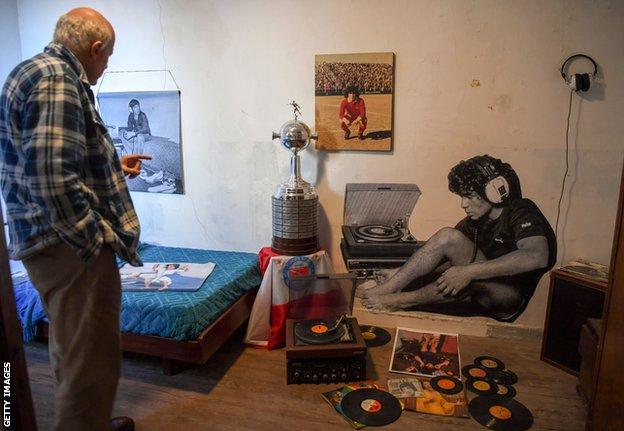
The 'Casa de Dios' museum is located at the house where Maradona lived in La Paternal, owned by Alberto Perez
Argentinos Juniors are based in the Buenos Aires neighbourhood of La Paternal, and in Argentina's capital city competition for players has always been fierce. River Plate, Boca Juniors, Racing Club, Independiente, San Lorenzo, Huracan, Velez Sarsfield, Ferro, Lanus, Banfield, Platense, and many more, are all within 50km.
With each club trying to catch, nurture and develop young talents, it is almost like fishing in a swimming pool. But Argentinos were always different. They don't just fish. They manufacture; they turn raw gems into polished diamonds. Their reputation owes everything to their teaching process.
"The difference with Argentinos Juniors has always been technique," says Roberto Saporiti, who managed the club in 1984 and was assistant coach to Cesar Menotti with Argentina at the 1978 World Cup.
"And it's not something new. They have been doing this for 50 years."
Saporiti and Menotti attended Maradona's professional debut in 1976, although he would be left out of their Argentina squad for the home tournament they won two years later. So many people later claimed to have been present at that first game that Maradona said: "If everyone who claims to have attended actually had, the game should have been played at the Maracana."
Maradona would go on to shine brightest of the stars discovered by the club's youth academy, but he is far from the only one. Argentinos define themselves as 'el semillero del mundo', the world's academy.
"It's a very accurate nickname," says Fernando Batista, a former Argentinos player and academy director who now manages the Argentina Under-20 team.
"So many amazing players were produced during the years that the list is almost never-ending. It's proof that it's not just one golden generation, but the result of hard work and a style that was never lost.
"Argentinos are a role model for the teaching and shaping of footballers, not just from the technical point of view but also from the human perspective. It's not a coincidence they've produced so many Argentina captains, from Maradona to [U20 captain] Diego Markic, to Juan Pablo Sorin."
Fernando Redondo, Juan Roman Riquelme, Sergio Batista, Fabricio Coloccini, Claudio Borghi and Esteban Cambiasso are just a few of the other full internationals they have produced over the years. Argentina's current U20 team captain is Atletico Madrid's 18-year-old defender Nehuen Perez - another Argentinos graduate.
Many talents left before the club benefited from their full potential - Riquelme, Coloccini and Cambiasso each departed before even being promoted to the first team, the first two to Boca Juniors and the last to Real Madrid.
But it was actually in the years immediately after Maradona's move to Boca that Argentinos enjoyed their period of greatest success, inspired by another singular talent: Jose Pekerman.

Jose Pekerman (fourth from left) receives a special presentation before a Colombia match against Costa Rica at Argentinos Juniors
The man who managed Argentina from 2004-2006 and Colombia from 2012-2018 was pulling the strings at Argentinos' academy in the 1980s.
The youth players he produced helped the first team win two league titles in 1984 and 1985 and the Copa Libertadores of 1985, then almost achieve victory over Michel Platini's Juventus in the Intercontinental Cup of the same year, losing on penalties.
His work at Argentinos would lead him first to the Argentina Under-20 job, and under his guidance they won four U20 World Cups: in 1995, 1997, 2001 and 2005. They were also awarded several Fair Play trophies, in stark contrast with what had happened at the 1991 tournament, when a massive fracas saw Argentina banned from the 1993 event.
Maradona's playing exploits aside, Argentinos' biggest connection with the national team remains Pekerman. But while the mid-1990s brought him success, his old club Argentinos were enduring a turbulent spell.
Desperately short of money, they accepted a broadcasting deal that forced them into playing their 1993-94 home games 1,000km away from Buenos Aires in the province of Mendoza. And in 1996, Boca Juniors bought Club Parque, a small feeder club that for years had provided Argentinos with some of their most promising players.
But despite financial worries, and with bigger clubs lurking, Argentinos have managed to keep their factory line going.
"There were ups and downs, wrong decisions, financial problems, but the academy always kept pointing north, which is why the whole system did not crash," says Saporiti.
Last season, striker Nicolas Gonzalez, now 21, was sold to Stuttgart for a reported £7.5m, a historic moment for the club as Maradona's record transfer fee was finally beaten - Argentinos had received around £6m from that sale to Boca and his subsequent move to Barcelona.
And it will soon be time to say farewell to 20-year-old Alexis MacAllister, who in January was sold to Brighton for around £6.5m before re-joining Argentinos on loan. "We have now restored our name abroad," said president Cristian Malaspina. MacAllister's brother, Kevin, was recently sold to Boca, too.
Argentinos have been relegated four times since 1996, but have bounced back to the top flight almost immediately each time, always thanks to their academy. At La Paternal, new generations blossom after every storm.
This season is a case in point - they finished bottom of the Superliga in April. As relegation is decided by teams' average points total over the past three years, they did not go down, but focus will switch to avoiding the drop next year.
Before then, there is still the domestic cup to fight for, and under new manager Diego Dabove, a specialist in working with youngsters, they recently defeated San Lorenzo in the Copa de la Superliga last-16 first leg, having already knocked out giants Independiente.
Victory marked the debut of 17-year-old Matko Miljevic, their latest prodigy. Born in Miami to Argentine parents, he spent seven years at the academy, scoring 49 goals in 107 games and is eligible to represent the United States, Argentina and Croatia.
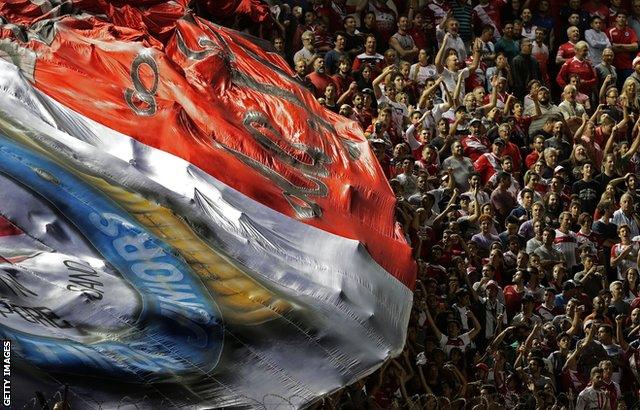
Argentinos Juniors fans cheering on their team during a home match against Boca Juniors
Argentinos Juniors have always been one of the clubs determined to back their talented youngsters.
"Control, control, control," Fernando Batista says. "Instep, pass, control, instep, pass..." Exercises by repetition.
"Argentinos have been doing these exercises for decades, and unlike other clubs, the players keep doing this when they're promoted [out of the academy].
"Tactics, strategy and intelligence can be enhanced over the years. But it's very difficult to change technique if you don't know how to control the ball properly. At Argentinos' academy, technique is non-negotiable."
At this small yet imposing ground, players should think twice before sending a long aerial ball up the pitch.
Half guardian, half gargoyle, a giant inflatable Diego Maradona watches every action from close at hand.


Maradona shares a welcome video message with Riquelme on his return to Argentinos in 2014
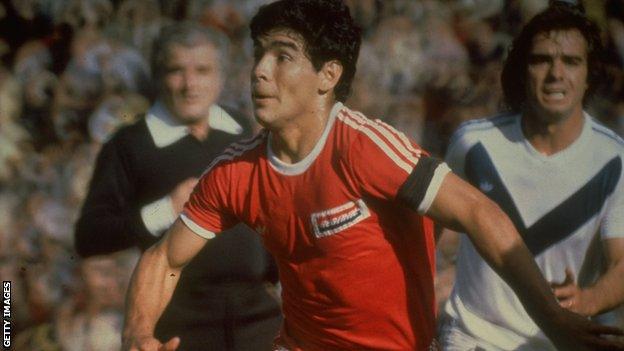
Maradona played 91 times for Argentina between 1977 and 1994, scoring 34 goals. He inspired his country to World Cup victory in 1986
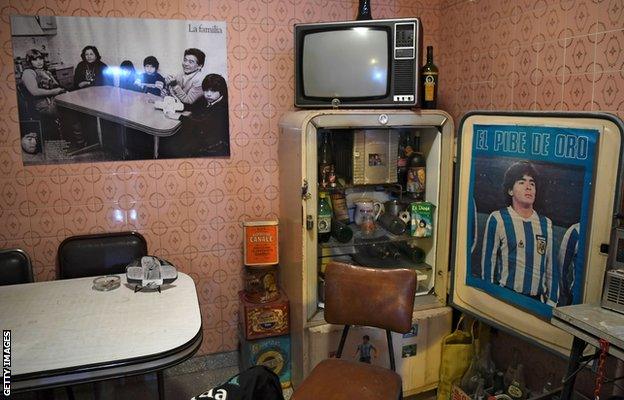
The flat Maradona was given after signing with Argentinos has been transformed into a museum
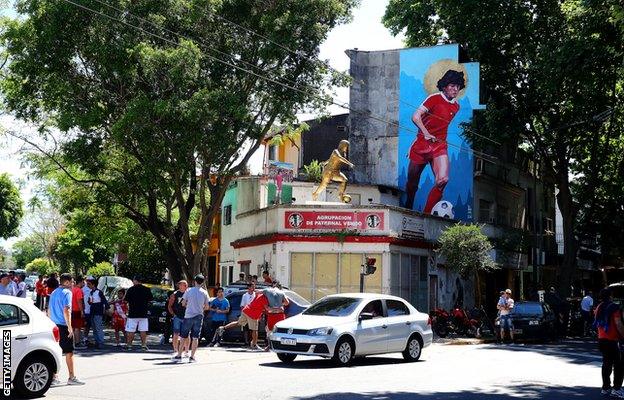
A mural paying homage to Diego Maradona outside Argentinos Juniors' ground
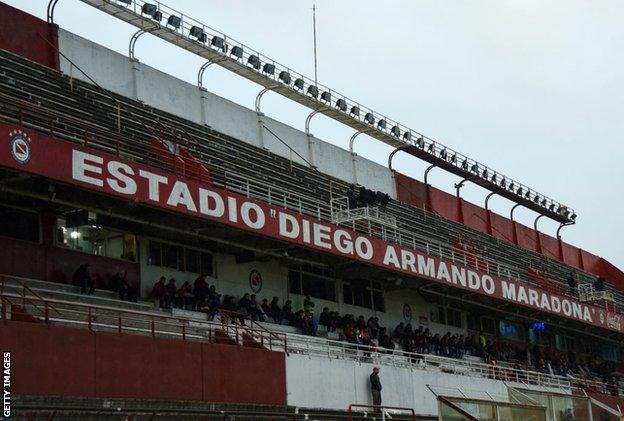
The Estadio Diego Armando Maradona holds about 26,000 people